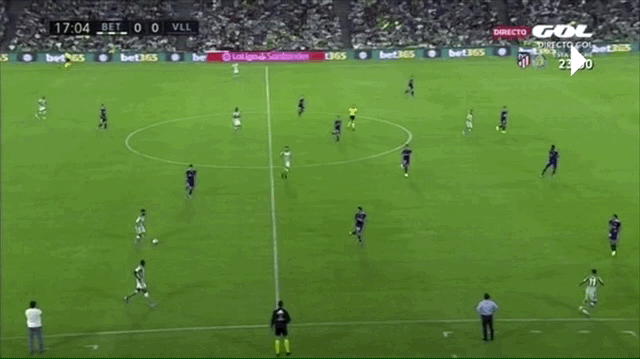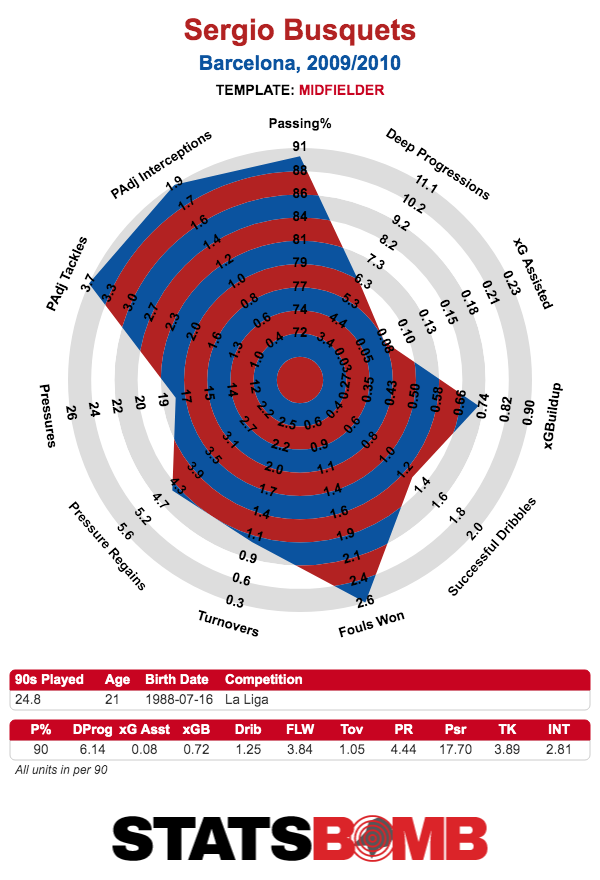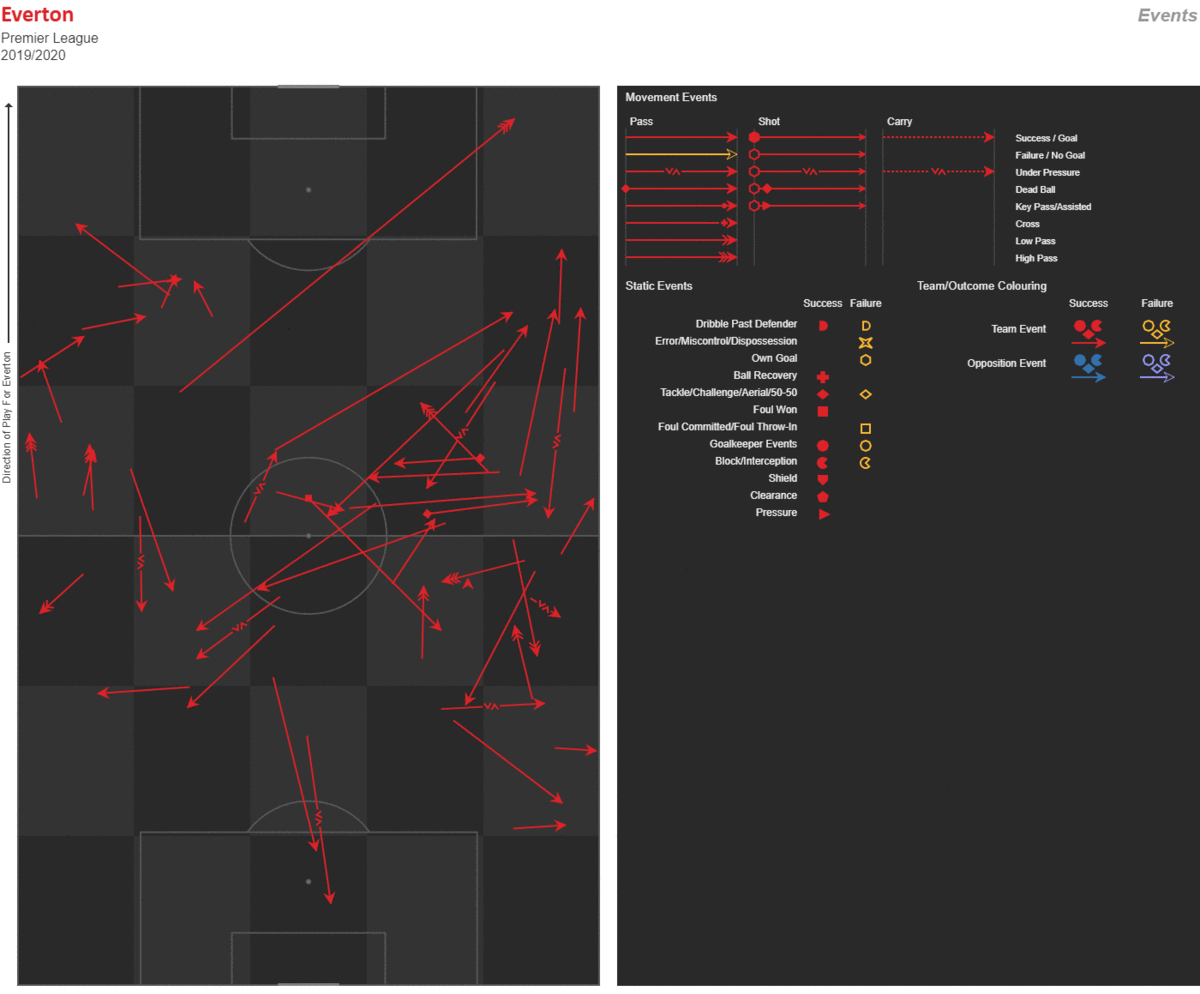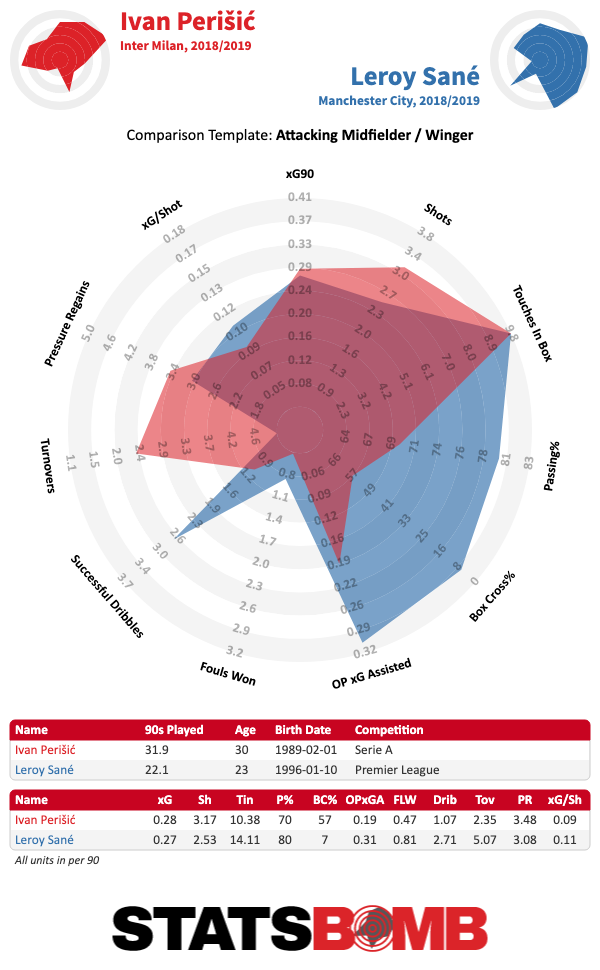The mental change that has transformed Martin Ødegaard from lost talent to decisive playmaker resembles the one that helped Zlatan Ibrahimović step up his game.
The year was 2004 and the Swede had joined Juventus from Ajax, where he had averaged about a goal every two league games. That wasn’t good enough for Fabio Capello, the Juve coach, who told him that he was going to knock the Ajax style out of him. What Capello wanted was fewer tricks and more goals, so he put Zlatan through relentless shooting drills. The drills flicked a switch. “A little of Ajax has stayed with me – the quality,” Zlatan has said. “But even if I now play out of the area more and always look to do the kind of move that motivates me, the first thought I have is to score and to win. That’s Capello’s lesson.”
A similar decisiveness has galvanised Martin Ødegaard, the Norwegian wunderkind. When Ødegaard joined Real Madrid at the age of 15, he began to flounder in the reserves, and the comparisons shifted from Lionel Messi to Freddy Adu. But at 20 Ødegaard has returned to Spain with Real Sociedad, whom he joined this summer on a two-year loan from Madrid. The playmaker has become a key cog at La Real after two games and struck a late winner at Mallorca on Sunday. While his touch is as silky as ever, his approach has changed since those troubled days in Madrid.
Back then Ødegaard arrived as a mini galáctico, having toured Europe with his family in search of a top club. As a kid who had danced around defenders twice his age (and size) in the Norwegian top flight, Ødegaard could pick and choose. Alongside his father, Hans Erik, a former professional footballer, he opted for Madrid, who told him that he would train with the first team and play for Castilla, the reserve team, who had just slid to the third division. Florentino Pérez invested a lot of time and personal prestige in luring him to the capital, and when Ødegaard touched down in January 2015, Madrid presented him in front of the press. Then the season turned into a disaster.
Castilla were on course for promotion under Zinédine Zidane, who was making his debut as head coach. But when Ødegaard showed up, their form dipped. Sections of the Madrid press reported that his wages – said to be £80,000 a week, but never confirmed – were causing jealousy in the squad. Ødegaard, it was reported, was failing to integrate with his teammates. By summer Castilla had finished seventh, Zidane looked bad and Ødegaard had his critics. Whether Ødegaard had actually made a negative contribution was questionable – Zidane looked lost as a tactician, and plenty of players deserved blame – but this was not the start anyone had in mind.
While Ødegaard settled more over the next 18 months, he seemed to have lost confidence along the way. The ambitious through balls had been replaced with square passes. Playing it safe made him harder to criticise, but also harder to praise. Then in January 2017, Madrid decided that a division packed with bruisers and muddy pitches in Basque mountain villages perhaps wasn’t the best place for a skinny 17-year-old to develop. When Ødegaard went on loan to Heerenveen, he had played 62 games for Castilla and scored five goals.
Another rough start awaited in the Netherlands. During the first months Ødegaard was benched and picked up an ankle injury, and he did not become a regular until the 2017/18 season. At that point everyone could see his talent: the silky first touch, the neat close control, the pirouettes, the killer passes weighed with perfection. At his best Ødegaard glides across the pitch, light as a feather, cutting inside on his left foot. Yet Ødegaard finished his first full Eredivisie season with two goals and one assist. How could such a talented player create so little?
While some stats suggested his output should have been better, Ødegaard needed to change something. By the time he had joined Vitesse on a one-year loan, he was working hard to boost his stats. He was practicing his shooting. He was focusing more on making the final pass. He did mental visualisation. The goal was to become more aggressive, direct and decisive. Stats are not everything, Ødegaard told a Dutch newspaper, but they do form the basis of trust.

After his first eight league games yielded one assist, Ødegaard got the boost he needed with a goal in a cup game against Heracles. Playing as a right midfielder in a 4-4-2, he went on to fire home nine goals and rack up 12 assists in 35 league games. Vitesse came fifth and he made the team of the season. He never burdened the team with slack defensive work, but showed the combination of creativity and industry that so many of the top coaches treasure. His expect assist per 90 of 0.34 was the fourth highest in the league.

The key to his creativity was not just a new resolve to try the unexpected, but the freedom granted to him by the coach, Leonid Slutsky, to drift into central positions.

Ødegaard might struggle to maintain his goalscoring rate at Real Sociedad. At Vitesse he would let rip near the edge of the box, which led to a modest non-penalty xG of 4.56. To keep up his average he might have to improve his ability to take up positions in the box, à la Mohamed Salah, although this is hard for a player who is so often involved in creating the chances in the first place. Alternatively Ødegaard might have to become a sniper à la Philippe Coutinho and hope to keep beating his xG from outside the box.

In any case Ødegaard’s primary function is as a playmaker. Real Sociedad missed a player of his kind last season, having lost Sergio Canales to Real Betis a year ago. The coach, Imanol Alguacil, has told Ødegaard to organise their attacks and make the final pass. Ødegaard has thrived in his first two outings. In his debut, a 1-1 draw at Valencia, he played as an attacking midfielder in a 4-2-3-1 and completed nearly twice as many final-third passes as anyone else.

At Mallorca on Sunday he was less influential – until he started a counter-attack that he finished off by lifting the ball over the keeper.
The promising start indicates that Ødegaard is back on track. He is yet to be taken off the pitch by Imanol, who is used to working with youngsters after spells with the club’s youth teams and the reserves. Ødegaard recently extended his contract with Madrid to 2023, a sign that Madrid have him in their plans. His aim for the next two years will be to show that he can be a key player in La Liga, and win a place at Madrid when the loan ends. Based on his displays so far, that goal at last seems to be within reach.


 Current reports suggest Hazard could return to action after the September international break. Until he does, Madrid will have to muddle on as is. Short Goal Kicks The updated laws of the game now allow for goal kicks to be received by players positioned inside the penalty area, and this new opportunity is certainly being put to use by La Liga’s teams. So far, there have been 67 goal kicks taken that way, 18.82% of the total. Only five teams are yet to attempt one. It feels like everyone is still working out the possibilities that these goal kicks provide. Only 11 of them have begun moves that successfully progressed into the attacking half. Just two of them have begun moves that have ended in shots, including this from Mallorca at home to Real Sociedad.
Current reports suggest Hazard could return to action after the September international break. Until he does, Madrid will have to muddle on as is. Short Goal Kicks The updated laws of the game now allow for goal kicks to be received by players positioned inside the penalty area, and this new opportunity is certainly being put to use by La Liga’s teams. So far, there have been 67 goal kicks taken that way, 18.82% of the total. Only five teams are yet to attempt one. It feels like everyone is still working out the possibilities that these goal kicks provide. Only 11 of them have begun moves that successfully progressed into the attacking half. Just two of them have begun moves that have ended in shots, including this from Mallorca at home to Real Sociedad.  Villarreal have, though, already provided us with a perfect illustration of how not to utilise them. They have been the most prolific takers of goal kicks into the box so far, with 57.89% of their kicks taken that way (Barcelona and Real Sociedad are joint second, on 46.15%). Only they and Real Sociedad have progressed past the halfway line more than once. But all that practice didn’t stop this disaster from occurring.
Villarreal have, though, already provided us with a perfect illustration of how not to utilise them. They have been the most prolific takers of goal kicks into the box so far, with 57.89% of their kicks taken that way (Barcelona and Real Sociedad are joint second, on 46.15%). Only they and Real Sociedad have progressed past the halfway line more than once. But all that practice didn’t stop this disaster from occurring.  Goalkeeper Andrés Fernández plays the ball left to central defender Pau Torres, who returns it to him. Upon receiving, Fernández takes a heavy touch that allows the fast-approaching Roger Martí to nip in ahead of him. Fernández clatters into Martí to concede the penalty that provided Levante with their winning goal in a 2-1 defeat for Villarreal. It came just five minutes after Levante had equalised from another clumsily conceded penalty, and meant that Villarreal failed to convert an entirely dominant first half into three points.
Goalkeeper Andrés Fernández plays the ball left to central defender Pau Torres, who returns it to him. Upon receiving, Fernández takes a heavy touch that allows the fast-approaching Roger Martí to nip in ahead of him. Fernández clatters into Martí to concede the penalty that provided Levante with their winning goal in a 2-1 defeat for Villarreal. It came just five minutes after Levante had equalised from another clumsily conceded penalty, and meant that Villarreal failed to convert an entirely dominant first half into three points.  It all seemed to get a bit too much for coach Javi Calleja, who had, after all, watched his side give up a 4-2 lead to draw 4-4 at home to Granada the week previous. One shot showed him slumped in his seat, limp quivering, desperation etched across his face. If his side continue to make such elementary errors, hopes of a return to the top 10 might have to be put on hold. Goals Are Still Hard To Come By Last season was the lowest scoring season in La Liga in over a decade, with an average of 2.54 goals per match that was down from 2.69 the previous campaign. That also held in terms of xG. Taking penalties out of the equation, the average non-penalty xG per match in La Liga fell from 2.26 in 2017-18 to 2.14 last time out. That downward shift has continued into the new season. There have been just 2.2 goals per match so far, and an average non-penalty xG of 1.71 per match. Minus a couple of aberrations like the aforementioned 4-4 draw between Granada and Villarreal and Barcelona’s 5-2 win over Real Betis, chances and goals have both proved hard to come by. Espanyol’s Attacking Struggles No team have struggled to create chances as much as Espanyol have. We are only two matches in and it is clearly far too early to draw substantive conclusions, but their attack has been nothing short of putrid so far. They are one of only two teams yet to score (Leganés are the other), and their shot map shows that isn’t simply a quirk of fate.
It all seemed to get a bit too much for coach Javi Calleja, who had, after all, watched his side give up a 4-2 lead to draw 4-4 at home to Granada the week previous. One shot showed him slumped in his seat, limp quivering, desperation etched across his face. If his side continue to make such elementary errors, hopes of a return to the top 10 might have to be put on hold. Goals Are Still Hard To Come By Last season was the lowest scoring season in La Liga in over a decade, with an average of 2.54 goals per match that was down from 2.69 the previous campaign. That also held in terms of xG. Taking penalties out of the equation, the average non-penalty xG per match in La Liga fell from 2.26 in 2017-18 to 2.14 last time out. That downward shift has continued into the new season. There have been just 2.2 goals per match so far, and an average non-penalty xG of 1.71 per match. Minus a couple of aberrations like the aforementioned 4-4 draw between Granada and Villarreal and Barcelona’s 5-2 win over Real Betis, chances and goals have both proved hard to come by. Espanyol’s Attacking Struggles No team have struggled to create chances as much as Espanyol have. We are only two matches in and it is clearly far too early to draw substantive conclusions, but their attack has been nothing short of putrid so far. They are one of only two teams yet to score (Leganés are the other), and their shot map shows that isn’t simply a quirk of fate.  In 180 minutes of action, against Alavés and Sevilla, Espanyol are yet to even create chances that add up to one third of an expected goal. They’ve taken just 10 shots and haven’t managed a single effort on target from inside the penalty area. Even allowing for the departure of last season’s top scorer Borja Iglesias that is a disastrous return. David Gallego’s side were expected to make a fast start to the campaign after beginning competitive action earlier than everyone else due to their participation in the Europa League qualifying rounds. After two defeats in two, they can at least take solace in a relatively accessible set of fixtures over the next couple of months, starting with Sunday’s match at home to Granada. But their attack will have to function much more effectively if they are to start getting some good points on the board.
In 180 minutes of action, against Alavés and Sevilla, Espanyol are yet to even create chances that add up to one third of an expected goal. They’ve taken just 10 shots and haven’t managed a single effort on target from inside the penalty area. Even allowing for the departure of last season’s top scorer Borja Iglesias that is a disastrous return. David Gallego’s side were expected to make a fast start to the campaign after beginning competitive action earlier than everyone else due to their participation in the Europa League qualifying rounds. After two defeats in two, they can at least take solace in a relatively accessible set of fixtures over the next couple of months, starting with Sunday’s match at home to Granada. But their attack will have to function much more effectively if they are to start getting some good points on the board.
 That's just the first half, but the whole of Liverpool against Arsenal very much looked the same. A remarkable congruence of tactics and the new goal kick rule that meant that Arsenal played really, really deep and essentially invited Liverpool to play ahead of their box, which in the main they did. Seriously, even Jose Mourinho back in late 2017 parking the bus at Anfield while shopping for a 0-0 and getting one looked very different, this Arsenal set-up was something else entirely:
That's just the first half, but the whole of Liverpool against Arsenal very much looked the same. A remarkable congruence of tactics and the new goal kick rule that meant that Arsenal played really, really deep and essentially invited Liverpool to play ahead of their box, which in the main they did. Seriously, even Jose Mourinho back in late 2017 parking the bus at Anfield while shopping for a 0-0 and getting one looked very different, this Arsenal set-up was something else entirely:  Was it fear? Last December, Liverpool hosted Arsenal and Unai Emery was chastened by a 5-1 drubbing that was 4-1 at the half with a pass network that looked like this:
Was it fear? Last December, Liverpool hosted Arsenal and Unai Emery was chastened by a 5-1 drubbing that was 4-1 at the half with a pass network that looked like this:  Just too open? Interestingly, only five players started both fixtures for Arsenal, which feels representative of the player flux that we've seen at the club. What really piqued my interest about last weekend's game was the half time shot count. Arsenal conceded 15 shots while taking five of their own in a half that as we've seen was played predominantly in one part of the pitch. Now the expected goal values of all these shots were closer together, Liverpool's 15 shots rated a mere 0.83 while Arsenal's measured at 0.6. So through one lens--expected goals, this was a close half. By other lenses, it wasn't. Many, many first halves of football finish with the two sides within a quarter of a goal in xG, just as in this game. Last season there were 122 in the Premier League alone. Of those 122 games, the maximum shot differential at the half was eight. So already here we have an outlier game: very close xG but not remotely close shot counts are scarce. How often did a team ship 15 shots in a first half last season? It's well known that shot rates tend to increase as matches progress, so even when you see a 30-plus shot beatdown, most of the time, the shots get racked up in the second half. And that's true here. Only four times in 2018-19 did a team reach the half time point having allowed 15 or more shots. Three of those matches were small teams flailing around against Manchester City and the other, oddly, was Newcastle versus Huddersfield. All this brings to the boil a personal frustration of mine. Expected goals is a useful tool in many aspects of analysis, but it's not the only one. What actually happened in this half of football over and above the modelled value of the chances? To allow 15 shots of any kind in a half is a clear sign that a defensive plan isn't working. Take Liverpool's left flank, expertly patrolled by Andrew Robertson and Sadio Mané with Georginio Wijnaldum shuttling across. It was very easy for these guys to progress, here are Robertson's first half ball carries and passes:
Just too open? Interestingly, only five players started both fixtures for Arsenal, which feels representative of the player flux that we've seen at the club. What really piqued my interest about last weekend's game was the half time shot count. Arsenal conceded 15 shots while taking five of their own in a half that as we've seen was played predominantly in one part of the pitch. Now the expected goal values of all these shots were closer together, Liverpool's 15 shots rated a mere 0.83 while Arsenal's measured at 0.6. So through one lens--expected goals, this was a close half. By other lenses, it wasn't. Many, many first halves of football finish with the two sides within a quarter of a goal in xG, just as in this game. Last season there were 122 in the Premier League alone. Of those 122 games, the maximum shot differential at the half was eight. So already here we have an outlier game: very close xG but not remotely close shot counts are scarce. How often did a team ship 15 shots in a first half last season? It's well known that shot rates tend to increase as matches progress, so even when you see a 30-plus shot beatdown, most of the time, the shots get racked up in the second half. And that's true here. Only four times in 2018-19 did a team reach the half time point having allowed 15 or more shots. Three of those matches were small teams flailing around against Manchester City and the other, oddly, was Newcastle versus Huddersfield. All this brings to the boil a personal frustration of mine. Expected goals is a useful tool in many aspects of analysis, but it's not the only one. What actually happened in this half of football over and above the modelled value of the chances? To allow 15 shots of any kind in a half is a clear sign that a defensive plan isn't working. Take Liverpool's left flank, expertly patrolled by Andrew Robertson and Sadio Mané with Georginio Wijnaldum shuttling across. It was very easy for these guys to progress, here are Robertson's first half ball carries and passes:

 They let Liverpool push onto their full-backs and this made outlet balls difficult to complete. The point here is that the outcome of this half was inevitable when factored against the tactics Arsenal deployed. It's easy to grasp the Pépé chance and feel it was potentially decisive, but it's only a one in three opportunity, and he's not even in the box. A style of play that struggles to even gain possession outside its own half is fairly doomed to failure. We saw the same the week before during Manchester City versus Tottenham. Here's Tottenham's pass map for minutes 30 to 50:
They let Liverpool push onto their full-backs and this made outlet balls difficult to complete. The point here is that the outcome of this half was inevitable when factored against the tactics Arsenal deployed. It's easy to grasp the Pépé chance and feel it was potentially decisive, but it's only a one in three opportunity, and he's not even in the box. A style of play that struggles to even gain possession outside its own half is fairly doomed to failure. We saw the same the week before during Manchester City versus Tottenham. Here's Tottenham's pass map for minutes 30 to 50:

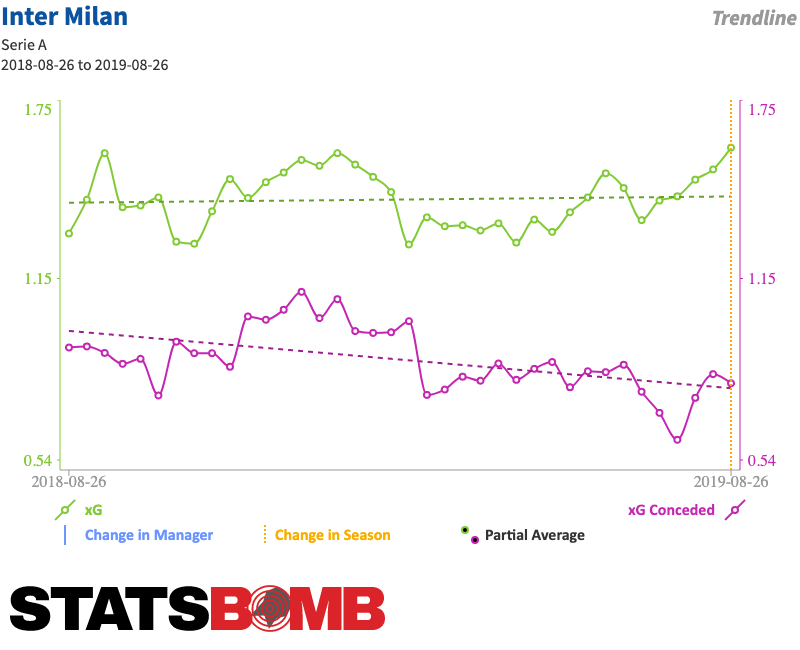






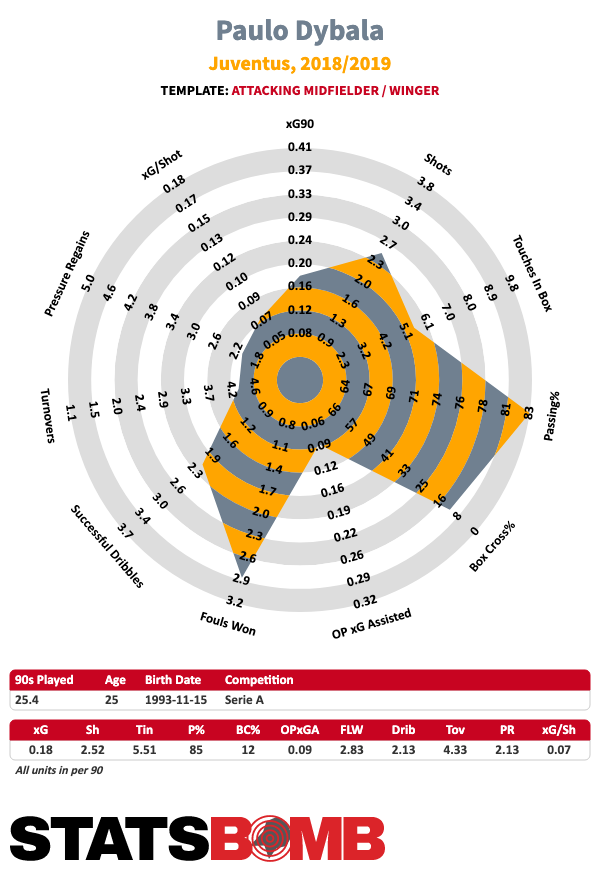

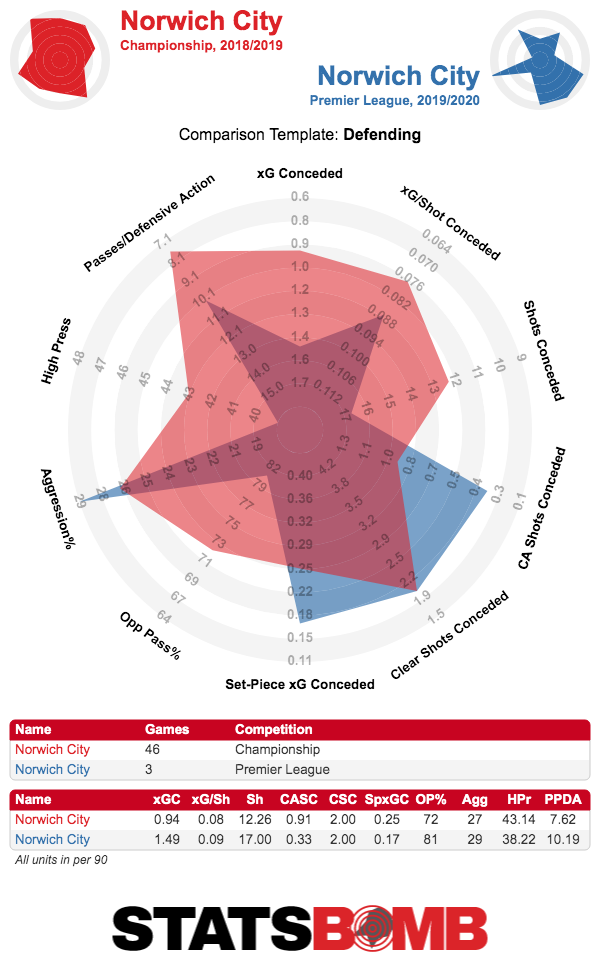
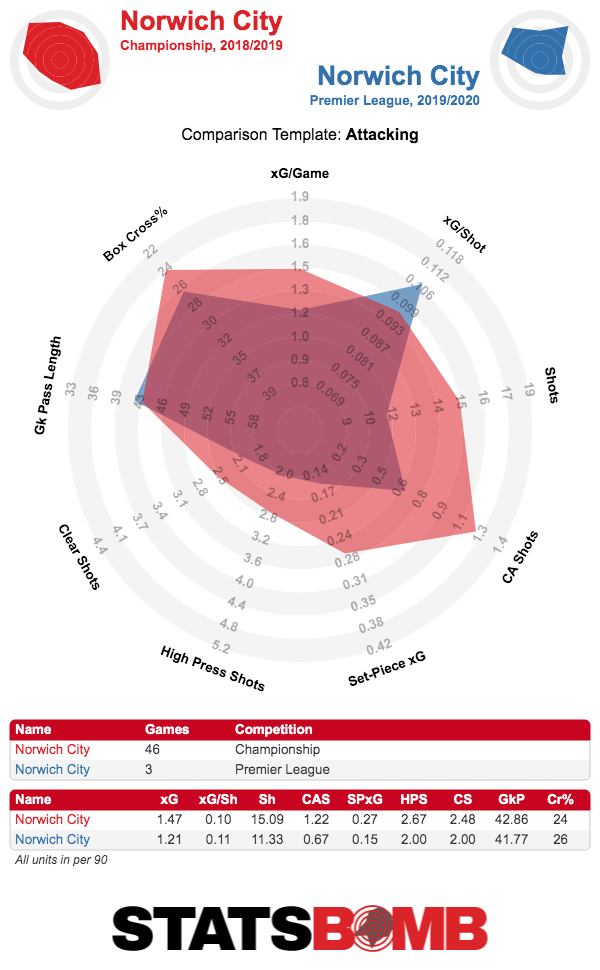




 Surely, the team that is in the best position to conquer Juventus, also by virtue of their results from the last few seasons is Napoli. Of the 2018/19 top-six teams, Azzurri is the only one, apart from Atalanta to have retained their coach, as well as having confirmed virtually all the players of last season. Among the players who left the team, the only one who played a significant amount of minutes was Albiol (1843 minutes). Last season Napoli led the league in non-penalty expected goals per game (1.65, tied with Atalanta), non-penalty expected goals conceded per game (0.81) shots per game(18.5), clear shots per game (3.9) and clear shots per game conceded (1.7).
Surely, the team that is in the best position to conquer Juventus, also by virtue of their results from the last few seasons is Napoli. Of the 2018/19 top-six teams, Azzurri is the only one, apart from Atalanta to have retained their coach, as well as having confirmed virtually all the players of last season. Among the players who left the team, the only one who played a significant amount of minutes was Albiol (1843 minutes). Last season Napoli led the league in non-penalty expected goals per game (1.65, tied with Atalanta), non-penalty expected goals conceded per game (0.81) shots per game(18.5), clear shots per game (3.9) and clear shots per game conceded (1.7). 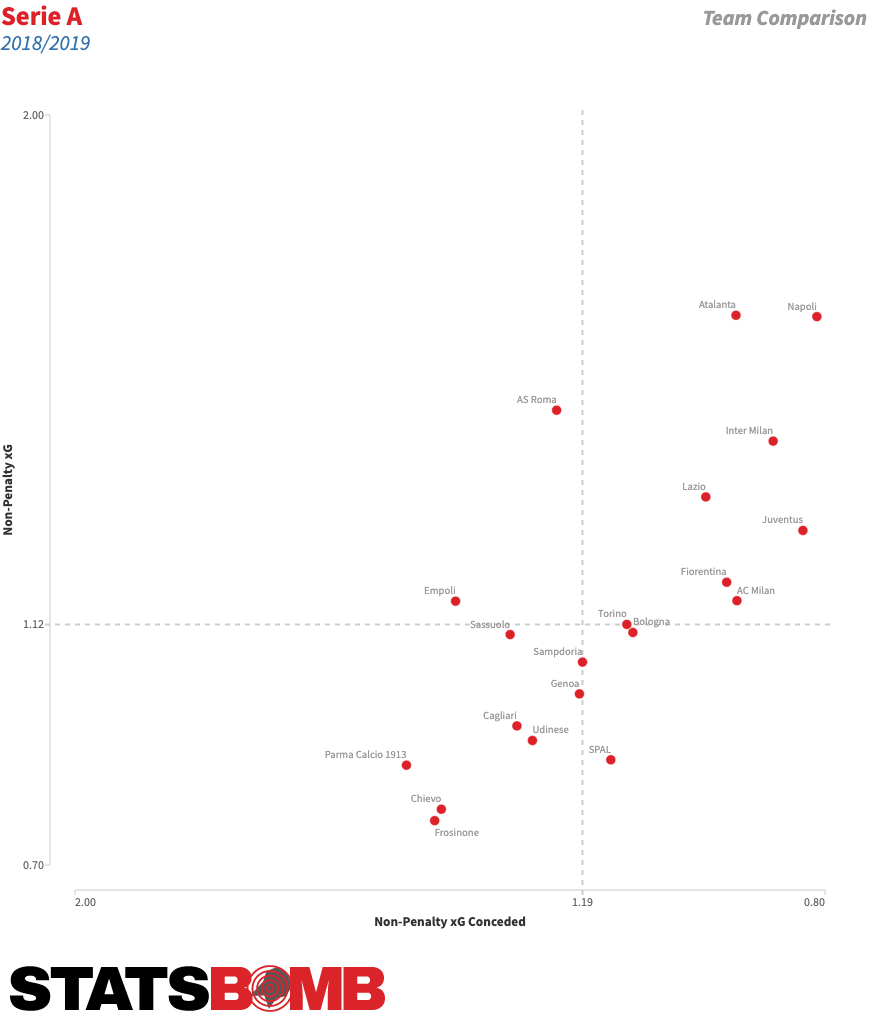 Analyzing their underlying numbers, they very much profiled as potential Serie A contenders, yet they were not able to seriously compete for the title and finished the season in second place, 11 points behind their Bianconeri rivals, who failed to win the last five matches of their season. They even equaled, if not topped Juventus defensive profile as a team, but it was still not enough to overcome them. Indeed, Allegri's team were an unconventional behemoth grinding out points perhaps thanks to the technical superiority of its players even without producing the numbers of a "super-team".
Analyzing their underlying numbers, they very much profiled as potential Serie A contenders, yet they were not able to seriously compete for the title and finished the season in second place, 11 points behind their Bianconeri rivals, who failed to win the last five matches of their season. They even equaled, if not topped Juventus defensive profile as a team, but it was still not enough to overcome them. Indeed, Allegri's team were an unconventional behemoth grinding out points perhaps thanks to the technical superiority of its players even without producing the numbers of a "super-team".  In essence, even if Napoli was able, at least sporadically, to excite its fans, the judgment on last season has remained pending (if not negative) for the lack of appreciable results and because none of the key players made the leap that many expected, given Ancelotti's reputation as a coach capable of getting the most out of the best players of his team - every reference to Lorenzo Insigne's new role as a second striker is, alas, intentionally not accidental.
In essence, even if Napoli was able, at least sporadically, to excite its fans, the judgment on last season has remained pending (if not negative) for the lack of appreciable results and because none of the key players made the leap that many expected, given Ancelotti's reputation as a coach capable of getting the most out of the best players of his team - every reference to Lorenzo Insigne's new role as a second striker is, alas, intentionally not accidental.  In his first season at Napoli, Carlo Ancelotti made the team that belonged to Sarri his own, developing a chameleonic formation capable of adapting to the opponent and the different situations of the game, while maintaining its own precise identity of play. It's no coincidence, then, that in a team where there's no room for specialists, that Fabian Ruiz - the best rookie of the Serie A last season, if you ask me - has come to the fore, to the point of making it no pain to sell club-legend midfielder Marek Hamsik.
In his first season at Napoli, Carlo Ancelotti made the team that belonged to Sarri his own, developing a chameleonic formation capable of adapting to the opponent and the different situations of the game, while maintaining its own precise identity of play. It's no coincidence, then, that in a team where there's no room for specialists, that Fabian Ruiz - the best rookie of the Serie A last season, if you ask me - has come to the fore, to the point of making it no pain to sell club-legend midfielder Marek Hamsik.  During the summer, Ancelotti, the coach who returned to Italy last season after nine years abroad, worked further to make his team as flexible as possible (in fact almost no one, if not perhaps Koulibaly and Allan, is irreplaceable) and even more fluid in moving across the pitch to efficiently occupy spaces, especially those between the lines. It seems certain that Napoli will defend with two lines of four, but offensively Ancelotti likes to shuffle the deck and so far, he fielded his team in a 3-4-2-1 with a fullback advanced in midfield or even in a more elaborated 3-1-3-3. The idea is to have more solutions and be less predictable. Indeed, even if in 2018/19 they were the best attack in terms of xG generated, sometimes Napoli's game seemed uninspired and they were unable to turn their territorial supremacy in goals. At the same time, the management tried to improve the team via the transfer market. In their attempt to pose a serious threat to Juventus, Napoli added Kostas Manolas and Hirving Lozano to the team, while also buying Empoli's right-back Giovanni Di Lorenzo and 19-year old midfielder Eljif Elmas from Fenerbache. At Roma, Manolas has for years been one of the best defenders of the league and, together with Koulibaly, will form a formidable centre-back pairing, at least in terms of speed and athleticism. The Greek is a defender with clear virtues and weaknesses but should be an improvement over the soon to be 34-year-old Albiol who left for Villareal and this move will allow Ancelotti to keep his defensive line higher. Lozano, the club's most expensive signing ever at €38+4 million, is an intriguing purchase because it is not immediately clear where he will play. At PSV he played on the left under Cocu, but last season he was moved to the right side (with occasional stints on the left) by Van Bommel. Ancelotti could even use him behind a striker or as the main striker, something he has alluded to himself.
During the summer, Ancelotti, the coach who returned to Italy last season after nine years abroad, worked further to make his team as flexible as possible (in fact almost no one, if not perhaps Koulibaly and Allan, is irreplaceable) and even more fluid in moving across the pitch to efficiently occupy spaces, especially those between the lines. It seems certain that Napoli will defend with two lines of four, but offensively Ancelotti likes to shuffle the deck and so far, he fielded his team in a 3-4-2-1 with a fullback advanced in midfield or even in a more elaborated 3-1-3-3. The idea is to have more solutions and be less predictable. Indeed, even if in 2018/19 they were the best attack in terms of xG generated, sometimes Napoli's game seemed uninspired and they were unable to turn their territorial supremacy in goals. At the same time, the management tried to improve the team via the transfer market. In their attempt to pose a serious threat to Juventus, Napoli added Kostas Manolas and Hirving Lozano to the team, while also buying Empoli's right-back Giovanni Di Lorenzo and 19-year old midfielder Eljif Elmas from Fenerbache. At Roma, Manolas has for years been one of the best defenders of the league and, together with Koulibaly, will form a formidable centre-back pairing, at least in terms of speed and athleticism. The Greek is a defender with clear virtues and weaknesses but should be an improvement over the soon to be 34-year-old Albiol who left for Villareal and this move will allow Ancelotti to keep his defensive line higher. Lozano, the club's most expensive signing ever at €38+4 million, is an intriguing purchase because it is not immediately clear where he will play. At PSV he played on the left under Cocu, but last season he was moved to the right side (with occasional stints on the left) by Van Bommel. Ancelotti could even use him behind a striker or as the main striker, something he has alluded to himself.  Probably, as his radar shows, the Mexican's best quality is his goal-scoring ability (he scored 17 times in both of his two Eredivisie seasons). While the transition from the Eredivisie to Serie A won't be easy, Napoli needs someone else to rely on when it comes to scoring goals other than Milik and Mertens, who generated 42% of the total xG and scored 45% of the goals last season. This is more relevent when considering the Polish striker's injury history (incidentally, he won't take part to the season debut against Fiorentina) and Mertens' drop in production likely due to aging (his shots average declined in each of the last three seasons). To add depth to their attack the Azzurri seem about to purchase Llorente, while a move for Icardi seems unlikely. But Lozano could contribute in other ways too. At PSV he had minimum defensive responsibilities and given his technical superiority a free role in attack that led to him taking high risks when passing and carrying the ball (as shown by a high number of turnovers and his low passing percentage). At Napoli, he will play in a different environment offensively in which more well-rounded qualities could emerge in multiple ways. In this sense, Lozano seems particularly suited to Ancelotti's idea of having a positionally fluid team, in which players are required to be able to perform different roles and duties. He could even put Insigne on the bench at a later stage of the season. Napoli have room for improvement in regards of the average quality of chances created and in shot distance (18.1 meters on average) and benching a trigger-happy inside forward who averaged 4.7 shots per 90 and 0.07 xG/shot last season could help. I don't consider Insigne a one-dimensional player, but Lozano seems more suited to Ancelotti's fluid system due to his unpredictability. Regardless of how the team hierarchies will change, Napoli still seems to lack something to compete with Juventus, at least in terms of overall quality. The purchases of Manolas and Lozano are certainly important to raise the collective value of the team, but it would take another effort to try to get closer to the champions of Italy. There are still almost 10 days left before the end of the transfer window and who knows if the club does not make a final attempt for Real Madrid's James Rodriguez, a player reportedly chased throughout the transfer campaign and perfect for Ancelotti's brand of football. If the roster stays more or less as it is today, Ancelotti, who said he was confident about the improvements of the team, will have to overcome a brand-new challenge for him. Turning, in pure Aristotelian fashion, a team without superstars into a team far stronger than the sum of its parts. If he can achieve this a second Scudetto for him is available. Header image courtesy of the Press Association
Probably, as his radar shows, the Mexican's best quality is his goal-scoring ability (he scored 17 times in both of his two Eredivisie seasons). While the transition from the Eredivisie to Serie A won't be easy, Napoli needs someone else to rely on when it comes to scoring goals other than Milik and Mertens, who generated 42% of the total xG and scored 45% of the goals last season. This is more relevent when considering the Polish striker's injury history (incidentally, he won't take part to the season debut against Fiorentina) and Mertens' drop in production likely due to aging (his shots average declined in each of the last three seasons). To add depth to their attack the Azzurri seem about to purchase Llorente, while a move for Icardi seems unlikely. But Lozano could contribute in other ways too. At PSV he had minimum defensive responsibilities and given his technical superiority a free role in attack that led to him taking high risks when passing and carrying the ball (as shown by a high number of turnovers and his low passing percentage). At Napoli, he will play in a different environment offensively in which more well-rounded qualities could emerge in multiple ways. In this sense, Lozano seems particularly suited to Ancelotti's idea of having a positionally fluid team, in which players are required to be able to perform different roles and duties. He could even put Insigne on the bench at a later stage of the season. Napoli have room for improvement in regards of the average quality of chances created and in shot distance (18.1 meters on average) and benching a trigger-happy inside forward who averaged 4.7 shots per 90 and 0.07 xG/shot last season could help. I don't consider Insigne a one-dimensional player, but Lozano seems more suited to Ancelotti's fluid system due to his unpredictability. Regardless of how the team hierarchies will change, Napoli still seems to lack something to compete with Juventus, at least in terms of overall quality. The purchases of Manolas and Lozano are certainly important to raise the collective value of the team, but it would take another effort to try to get closer to the champions of Italy. There are still almost 10 days left before the end of the transfer window and who knows if the club does not make a final attempt for Real Madrid's James Rodriguez, a player reportedly chased throughout the transfer campaign and perfect for Ancelotti's brand of football. If the roster stays more or less as it is today, Ancelotti, who said he was confident about the improvements of the team, will have to overcome a brand-new challenge for him. Turning, in pure Aristotelian fashion, a team without superstars into a team far stronger than the sum of its parts. If he can achieve this a second Scudetto for him is available. Header image courtesy of the Press Association














